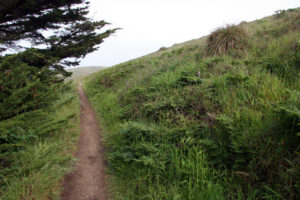May 19, 2012. Palomarin Beach (0.7 mi. each way)
Trail notes: an easy stroll from the parking area at the end of Mesa Road to the shore; 1.4 miles round trip.
Check out this and other hikes Jules has taken on this Google map. The most recent hike is in blue; others are in red.
Immediately after leaving the parking lot at the end of Mesa Road, Coast Trail enters the Philip Burton Wilderness. The trail crosses a small drainage dominated by invasive plants, especially blue gum eucalyptus and Scotch broom. Some of the eucs at the junction with the Palomarin Beach trail are gargantuan, multi-trunked specimens.
The half-mile trail to the beach passes through coastal sage scrub and riparian thickets. Cow parsnip (Heracleum lanatum) is abundant, in full bloom in May. Rising above the shorter shrubs, its flat-topped white umbels remind us that it is in the carrot family. Several small creeks feed fairly extensive willow thickets and small freshwater swales. On a still day like today, the pathway is patrolled by dragonflies and damselflies and several species of butterflies. California ringlets, a small pale brush-footed butterfly, are particularly common but too flighty to photograph.
-
The charming umber skipper (Poanes melane), a butterfly no bigger than a copper penny, on a sun-splash along the trail. The large head and body, relative to the small wings, is characteristic of the skipper family (Hesperiidae). Arthur Shapiro, author of Field Guide to Butterflies of San Francisco Bay and Sacramento Valley Regions (U.C. Press 2007) tells me this is a banner year for this diminutive species. Photo by Jules Evens.
Field crescent butterflies seem to be chasing on another, but when they land and spread their wings, they reveal the beautiful mosaic pattern. This striking species is most common in marsh swales such as found on the Palomarin Trail.
-
The field crescent butterfly (Phycoides pulchellus) belongs to the diverse brushfoot family (Nymphalidae), which includes a large number of subfamilies. Familiar brushfoots include the monarch, California sister, and West Coast lady. Photo by Jules Evens.
Where the trail meets the beach, the low, nearly-succulent-leaved bush with yellow flowers is lizard tail, a true maritime plant–“When in flower . . .seems to be encrusted with the purest gold . . . set off by blue of sky and ocean” (Marin Flora). It’s just budding up in mid-May, so by early June, its full beauty should shine.
The beach is cobbled with wave-smoothed shales. The rocks have been sorted selectively by the waves with larger cobbles higher on the beach and their size decreasing down toward the tideline. Among the smooth cobbles on the higher beach are some pocked with holes.
-
Pocked beach rocks. Photo by Jules Evens.
These rocks have been sculpted by mollusks known as rock-boring pholad clams. They bore into shale and sandstone by mechanical abrasion. While holding on with their foot, they rock the toothed edge of their shell back-and-forth rhythmically, excavating a perfectly circular cavity into which they settle and continue to grow until they are imprisoned. Once encased, the mollusks are safe from predators and simply siphon plankton out of the water. Notice the shell in the deep hole on the upper portion of this cobble.
The cobbled beach is remarkably free of debris. But the weathered carapaces of rock crabs are strewn by the hundreds along the half-mile of beach up to Abalone Point. Most are smaller than the 4.25-inch minimum allowed to be kept by crabbers, so I wonder if these are discarded by-catch, or if there has been a die-off.
-
Pacific or red rock crab, Romaleon antennarius (formerly in the genus Cancer). The black tips to the front claws are diagnostic as are red speckles on the underside which distinguish it from another red rock crab (Cancer productus) and the commercially harvested Dungeness (Cancer magister). Photo by Jules Evens.
As I sit on a make-shift driftwood bench for a snack and a drink, a black oystercatcher lands at the water’s edge.
The oystercatcher is known as one of the true “rock stars” of the bird world, because it rarely wanders away from the wave-splashed, rocky shore. It’s a large shorebird (17.5 inches, stem to stern) with a chisel-like bill designed for prying barnacles, limpets, and mussels from the splash zone. But this one is just staring out at the ocean, seeming to contemplate the gentle rhythm of the swells, as I am. After about 10 minutes, he flies off toward Abalone Point.
Critter List
Invertebrates
Acmon Blue butterfly
California Ringlet butterfly
Field Crescent butterfly
Pale Swallowtail butterfly
Umber Skipper butterfly
Several unidentified odonates (dragonflies and damselflies)
Herps (reptiles and amphibians)
Western Fence Lizard
Western Terrestrial Garter Snake
Birds
Allen’s Hummingbird
American Crow
American Goldfinch
American Robin
Band-tailed Pigeon
Bewick’s Wren
Black Oystercatcher
Black-headed Grosbeak
Brandt’s Cormorant
Brown Pelican
Bushtit
California Gull
California Quail
Caspian Tern
Chestnut-backed Chickadee
Common Raven
Cooper’s Hawk
Double-crested Cormorant
Hutton’s Vireo
MacGillivray’s Warbler
Northern Flicker
Olive-sided Flycatcher
Orange-crowned Warbler
Osprey
Pacific-slope Flycatcher
Pelagic Cormorant
Pigeon Guillemot
Purple Finch
Red-tailed Hawk
Red-throated Loon
Song Sparrow
Spotted Towhee
Surf Scoter
Swainson’s Thrush
Turkey Vulture
Western Grebe
Western Gull
Western Scrub-Jay
Wilson’s Warbler
Wrentit
Mammals
Harbor Seal





